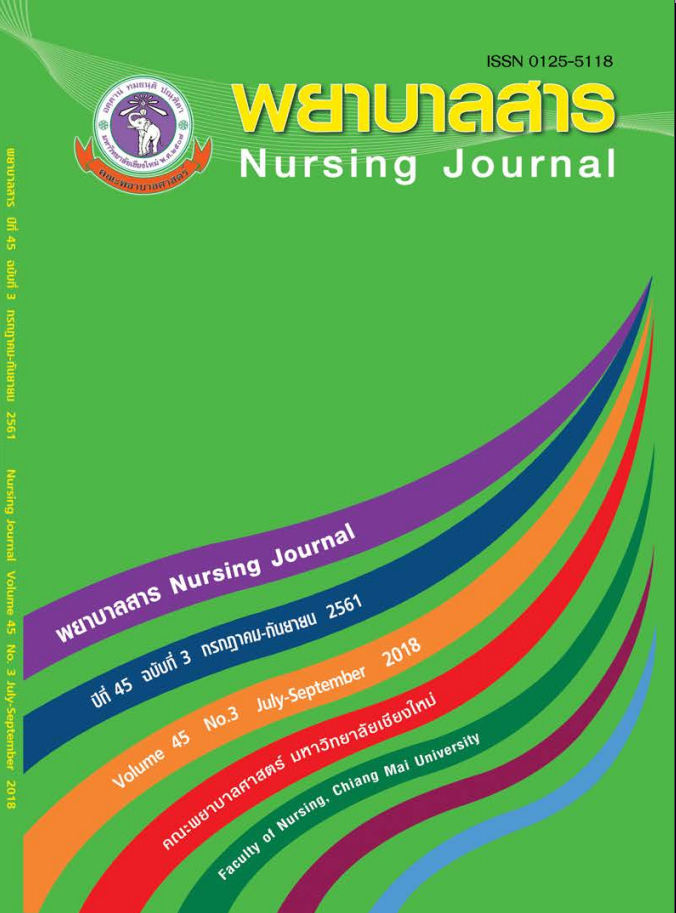การพัฒนากล่องจำลองการตรวจภายในเพื่อฝึกประเมินความก้าวหน้าของการคลอด
คำสำคัญ:
กล่องจำลองการตรวจภายใน, การประเมินความก้าวหน้าของการคลอด, นักศึกษาพยาบาลบทคัดย่อ
การพัฒนากล่องจำลองการตรวจภายในเพื่อใช้ในการเรียนการสอนทางคลินิก มีส่วนสำคัญที่ช่วยให้ผู้เรียนเข้าใจและมีทักษะในการปฏิบัติงานก่อนปฏิบัติกับผู้รับบริการในคลินิก วัตถุประสงค์ของการวิจัยและพัฒนาครั้งนี้ เพื่อพัฒนาและประเมินประสิทธิภาพกล่องจำลองการตรวจภายในเพื่อฝึกประเมินความก้าวหน้าของการคลอด ซึ่งมีการดำเนินงาน 2 ระยะ ดังนี้ 1) การพัฒนากล่องจำลอง และ 2) การนำกล่องจำลอง ไปทดลองใช้และประเมินประสิทธิภาพ กลุ่มตัวอย่าง คือ นักศึกษาพยาบาลที่ฝึกปฏิบัติงานในหน่วยห้องคลอด 67 คน ในระยะที่ 1 จำนวน 15 คน และระยะที่ 2 จำนวน 52 คน เครื่องมือที่ใช้ได้แก่ แนวคำถามเกี่ยวกับหุ่นจำลองการตรวจภายในและแบบประเมินคุณภาพหุ่นจำลองการตรวจภายใน ซึ่งได้รับการตรวจสอบจากผู้ทรงคุณวุฒิ 3 ท่าน ได้ค่าดัชนีความตรงตามเนื้อหา (CVI) เท่ากับ 1.00 และหาค่าความเชื่อมั่นของแบบประเมินคุณภาพหุ่นจำลองเต้านมโดยการทดสอบซ้ำกับนักศึกษาพยาบาลจำนวน 10 คนได้ค่าความเชื่อมั่นเท่ากับ 0.96 วิเคราะห์ข้อมูลโดยใช้สถิติเชิงบรรยาย ได้แก่ ค่ามัธยฐาน ค่าเฉลี่ย และส่วนเบี่ยงเบนมาตรฐาน
ผลการวิจัยได้กล่องจำลองการตรวจภายในเพื่อฝึกประเมินความก้าวหน้าของการคลอด ซึ่งมีโครงสร้างทำด้วยไม้ที่จำลองเป็นช่องทางคลอดและแผ่นพลาสติกที่ติดยางพาราซึ่งทำเป็นปากมดลูกและศีรษะทารกที่มีหลายขนาด เมื่อนำกล่องจำลองการตรวจภายในฯ นี้ มาทดลองใช้และประเมินประสิทธิภาพพบว่า กล่องจำลองการตรวจภายในมีประสิทธิภาพในด้านการผลิตและด้านทักษะการเรียนรู้อยู่ในระดับพอใช้ ขณะที่ด้านความมั่นใจอยู่ในระดับดี แม้ว่ากล่องจำลองการตรวจภายในฯ นี้ ใช้อธิบายและฝึกทักษะในการประเมินความก้าวหน้าของการคลอดได้ แต่ยังต้องการการพัฒนาให้ดียิ่งขึ้นและเหมาะสมทั้งด้านการผลิตและด้านทักษะการเรียนรู้ต่อไป
เอกสารอ้างอิง
models for nursing students. Journal of Nursing Education and Practice, 6 (9):
101-109.
Translated Thai References
Daungrat, B., Yantarapakon, A., Jirasinthipok, T., Sayorwan, W., Ratanawiboolsook, N. & Saleepang, N. (2009). Development of Latex Arm Model for Suturing Practice. Journal of Public Health and Development. 7 (1): 47-60 (in Thai).
Yaowalak Kumkwan, Y. & Chaiyawut, P. (2014). The Development of Endotracheal-tube and Tracheostomy-tube Suction Models for Suction Skill Practice. Journal of Phrapokklao Nursing College, 25 (2): 52-64 (in Thai).
Kunawittikul, W. (2005). Model Teaching Method. Chiang Mai: Chotana (in Thai).
The Nursing Council of Thailand. (1997). Professional Nursing and Midwifery Act (No.2), 1997. Bangkok: The Best (in Thai).
Yimyam, S., & Karnasuta, S. (2013). Developing breast model for teaching breastfeeding. Nursing Journal, 40 (4): 58-68 (in Thai).
Yimyam, S. (2016). Developing simulation model for training clinical skill of health science students. Nursing Journal, 43 (2): 142-151 (in Thai).
Suprasert, A. (2015). Latex Model: Eco media for education. Retrieved December, 12, 2015 from http://www.rdi.ku.ac.th/bk/04/04.htm (in Thai).
Nimusa, A., Chittithavorn, V., & Rergkliang C. (2008). A medical mannequin for practicing tube thoracostomy. Songklanagarind Medical Journal, 26(5): 513-517 (in Thai).
ดาวน์โหลด
เผยแพร่แล้ว
รูปแบบการอ้างอิง
ฉบับ
ประเภทบทความ
สัญญาอนุญาต
บทความที่ได้รับการตีพิมพ์เป็นลิขสิทธิ์ของวารสารพยาบาลสาร
ข้อความที่ปรากฏในบทความแต่ละเรื่องในวารสารวิชาการเล่มนี้เป็นความคิดเห็นส่วนตัวของผู้เขียนแต่ละท่านไม่เกี่ยวข้องกับมหาวิทยาลัยเชียงใหม่ และคณาจารย์ท่านอื่นๆในมหาวิทยาลัยฯ แต่อย่างใด ความรับผิดชอบองค์ประกอบทั้งหมดของบทความแต่ละเรื่องเป็นของผู้เขียนแต่ละท่าน หากมีความผิดพลาดใด ๆ ผู้เขียนแต่ละท่านจะรับผิดชอบบทความของตนเองแต่ผู้เดียว






